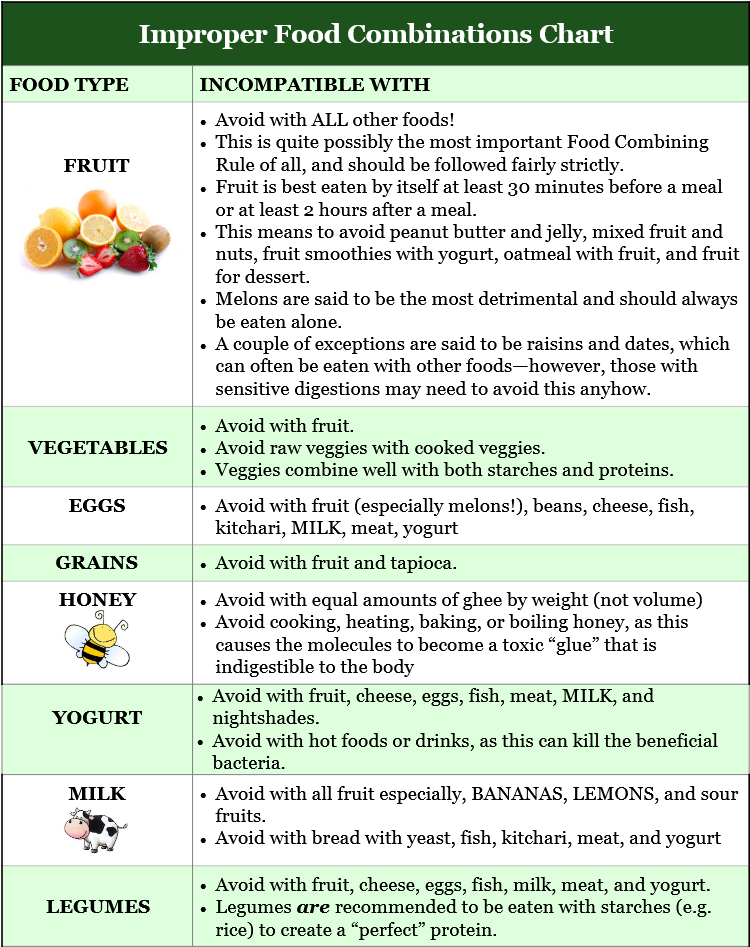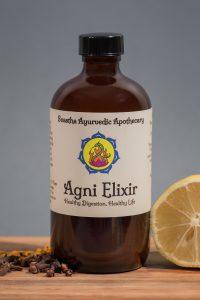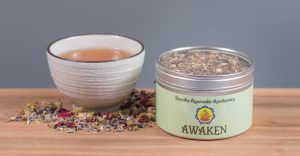 Food combining plays a major role in our digestive and overall health. According to Ayurveda, improper food combinations are a significant cause of multiple disorders and can lead to weak digestion, toxic accumulation, and eventually disease. Alternatively, there are many positive ways to combine foods to enhance absorption and get the most nutrition from your meals. Practicing these essential food combining rules can support optimal digestion, metabolism, energy, and overall health.
Food combining plays a major role in our digestive and overall health. According to Ayurveda, improper food combinations are a significant cause of multiple disorders and can lead to weak digestion, toxic accumulation, and eventually disease. Alternatively, there are many positive ways to combine foods to enhance absorption and get the most nutrition from your meals. Practicing these essential food combining rules can support optimal digestion, metabolism, energy, and overall health.
What is food combining?
The term food combining refers to eating two or more foods at or around the same time so they flow through the digestive tract together. Food combinations may have a positive effect, a negative effect, or a neutral effect on your health.
Why is food combining important?
Food combining can make or break how you digest a food or how well you absorb its nutrients. Improper food combining can make even the healthiest foods wreak havoc on your digestion, slow your metabolism, create toxicity, and deplete you of their vital nutrients.
Positive food combinations can help you digest food better, absorb nutrients more readily, and enhance healing properties. Whether you are dealing with malabsorption, chronic digestive issues, or are relatively healthy, proper food combining is vital for healing disorders and maintaining health.
Improper Food Combinations
Poor food combining is said to lead to fermentation, gas formation, indigestion, slow metabolism, weight gain, and even emotional imbalance. Over time, this habit creates toxicity and cellular confusion, leading to disorder and disease. Although these improper food combinations should all be avoided, some may be more detrimental than others, making it especially essential to eliminate them completely.
Therefore, listen to your body and bring awareness to how you combine your foods. You may be surprised to discover that your digestive issues may be mitigated by changing how you combine certain foods or food groups. This may explain why you digest a food perfectly fine one day, but it creates digestive distress another day. Think, what did I eat with this food (or earlier that day, if your digestion is slow)?
Ayurveda has a long list of improper food combinations. If you feel overwhelmed or stressed out just looking at this list, take a deep breath as I share with you some helpful tips.
Improper Food Combining Tips
- If you are new to food combining, start slow by adopting one or two new habits at a time rather than trying to conquer this entire list at once. I typically recommend starting with the “eat fruit by themselves” rule since this (in my opinion) is the most vital!
- Nobodies perfect! Eating an improper food combination once in a while is not as detrimental as eating the improper food combination regularly—so assuming it does not wreak total havoc, enjoy a little cheating from time to time.
- Cooking improper food combinations together can often make them “get along” better than if they were eaten separately.
- If you know you will be eating an improper food combination, you can often reduce its negative effects by taking a digestive aid such as our Agni Elixir or a DIY Ginger Appetizer before your meal.
- Adding digestive spices to a meal can also help reduce the negative effects of improper food combining.
- Maintaining a strong and healthy digestive fire (Agni) will aid in the digestion of improper food combining and reduce potential toxic build-up—but don’t overdo it, or you can weaken your digestive fire (Agni) over time.
- If you are dealing with chronic digestive issues, sluggish metabolism, obesity, or high levels of toxins, it will be best to be more strict until balance has been established—sorry!
Click here to get a printable PDF version of this chart.


Click here to get a printable PDF version of this chart.
A couple of modern-day additions:
With the help of Western science, we now know that some nutrient absorption can be inhibited by certain compounds. Here are a few to look out for:
- Avoid taking iron with food that contains tannins such as coffee, chocolate, and tea—iron is often said to absorb best on an empty stomach (but should be taken with Vitamin C).
- Avoid taking calcium with vitamin C or with foods that contain oxalates, such as spinach, carrots, beets, almonds, cashews, peanuts, chickpeas, black beans, quinoa, buckwheat, whole wheat, chocolate, coffee, and tea.
- Many legumes, grains, nuts, and seeds contain “anti-nutrients” that can reduce the absorption of vital minerals such as calcium, iron, magnesium, and zinc—soaking them before cooking or eating them removes many of these inhibitors and can be a great way to promote better absorption.
Healthy Food Combinations
Food combining is not all bad; in fact, there can be some positive food combinations that elevate the health properties of your food. Knowing what foods or nutrients to eat together will help you get the most out of your meals by enhancing their nutrition and supporting nutrient absorption.
1. Legumes and Starches
Combine legumes with starches to create a “perfect” protein, meaning they provide all 9 essential amino acids (most plant foods do not provide these on their own). Some examples include eating beans with rice, kitchari, hummus with a whole grain pita, or peanut butter on whole grain toast.
2. Iron and Vitamin C
Combine iron-rich foods (or supplements) with vitamin C to enhance the absorption of the iron. Taking iron on an empty stomach promotes absorption further. I often take my iron supplement alongside vitamin C-rich Triphala Churna on an empty stomach (before bed or first thing in the morning).
Purchase our handcrafted Triphala Churna here!
3. Calcium with Vitamin D and Magnesium
Vitamin D and magnesium promote the absorption of calcium when they are taken together. This is especially important for children, women over 40, and anyone experiencing osteopenia or osteoporosis. You can take a supplement that contains these three ingredients (such as PURE SYNERGY Bone Renewal), or you can eat your calcium-rich foods alongside vitamin D and magnesium-rich foods or supplements.
4. Vitamin D with K2 and a Healthy Fat
Vitamin D plays an important role in our energy, mood, bone health, immunity, and disease prevention. Since most of us do not absorb enough vitamin D from the sun, it is often helpful to take a supplement. However, to get the best absorption, make sure it is paired with vitamin K2 and taken with a healthy fat (such as coconut oil, whole milk dairy, or avocado). Taking it with whole milk dairy (if suitable) will provide the essential lipids while the vitamin D will support the absorption of calcium (win-win!!). I really like (and use) this vitamin D-K2 supplement here.
5. Colorful Veggies and a Healthy Fat
Like all fat-soluble nutrients, carotenoids (found in colorful veggies) absorb best when taken with a lipid source. Include a healthy fat (avocado, olive oil, coconut oil, etc) when eating red, green, and orange veggies for the best absorption of their essential carotenoids (a health-promoting antioxidant and precursor to vitamin A).
6. Lemon or Lime Juice
Add fresh lemon or lime juice to harder-to-digest meals to support digestion and absorption.
7. Digestive Spices
Add ginger and other digestive spices to a meal to enhance the absorption of nutrients and aid in digestion.
Discover our tridoshic Agni Churna Spice blend here!
8. Turmeric and Black Pepper
Take turmeric with black pepper to enhance the absorption of the curcumin in turmeric. You can find this duo in our Svastha Golden Milk blend!
Purchase our Svastha Golden Milk here.
9. Ghee and Honey (in unequal weight)
Ghee mixed with honey in unequal weight (e.g. 1 teaspoon of ghee and 1 teaspoon of honey) creates a rejuvenation tonic to enhance energy and rejuvenation. Use our rejuvenation ghee, Rasayana Ghrita, for even more potent results!
Discover our Rasayana Ghrita (rejuvenation ghee) here!
10. Food, Qualities, and Balance
Every food has its specific qualities. If you are sensitive to a certain food quality (hot, dry, heavy, light), you may be able to find balance by combining it with foods and spices of opposing qualities. For example, eating hot spicy foods with cooling substances such as ghee, coconut, cilantro, lime, fennel, or coriander; eating dry foods with ghee, sesame oil, olive oil, or avocado; or eating heavy foods with ginger, black pepper, cumin, or lemon juice. Of course, you should still honor moderation, but if you indulge from time to time, you may as well do so with intelligence:)
Conclusion
Food combining is an essential part of the Ayurvedic diet and has been honored for thousands of years. Combining the “wrong” foods can make a normally healthy, digestible food create malabsorption, gas, indigestion, and toxicity in your system. On the contrary, combining the proper foods can enhance balance, nutritional value, nutrient absorption, and their healing properties.
As with most of the food rules of Ayurveda, it is not an all-or-nothing practice—there is always a bit of room to play (intelligently). By using some of these helpful tips, you can enjoy an improper food combination on occasion while still keeping your digestion healthy and strong. So start slow, don’t stress, and cultivate a new sense of awareness around HOW you eat your foods!
Try our Agni Elixir to support healthy digestion!
Spark your digestive fire with our AWAKEN Tea!
Discover our full line of digestive spices!






Hi there Danielle,
Your cookbook is my go to for ayurvedic recipes. There are some nice
Heart healthy recipes. Since I found out that I have a leaky heart valve and am 86 now I wonder if you have any more information regarding food that I should incorporate or be aware of. I am a vegetarian.
Thank you Danielle. Hope life is treating you wel
All the best. Namaste.
Iona.
Hi Iona,
It is great to hear from you! The best foods for the heart would be fiber-rich foods, foods high in omega-3s, nuts and seeds, and colorful, antioxidant-rich plant foods. Avoid saturated fats and excessive salt. Favor pink salt (in small amounts) and healthy oils such as olive oil, flax oil, and avocado.
Getting daily movement (like fresh air walks) without overdoing it is essential as well. And above all, keep stress low with regular self-care practices!
Take it slow and be well, my friend:)
Namaste,
Danielle